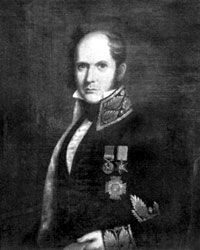- William Henry Sleeman
Infobox Person
name = William Henry Sleeman

caption =
birth_date = 1788
birth_place =
death_date = 1856
death_place =
other_names =
known_for =
occupation =
relatives =
spouse =
website =
footnotes =Sir William Henry Sleeman (
August 8 ,1788 -February 10 ,1856 ) was a British soldier and administrator in India.A great admirer of India's rich natural beauty,he was born in
Stratton, Cornwall , the son of Philip Sleeman, a yeoman and supervisor ofexcise . In 1809 William joined theBengal Army , served in theNepal War (1814-1816), and in 1820 became assistant to the Governor-General's agent in theSaugor andNerbudda territories.He is best known for his suppression of the
Thuggee secret society, becoming superintendent of the operations against them in 1835, and commissioner for the suppression of Thuggee andDacoity in 1839. During these operations, more than 1400 Thugs were hanged or transported for life. One of them, Bahram, confessed to have strangled 931 persons with his turban. Detection was only possible by means of informers, for whose protection from the vengeance of their associates a special prison was established atJabalpur (at the time "Jubbulpore").Sleeman was also the earliest discoverer of
dinosaur fossil s inAsia . In 1828, serving as a Captain in theNarmada valley region, he noticed severalbasalt ic formations which he identified as having been "raised above the waters". By digging around in the Bara Simla Hills, part of theLameta formation near Jabalpur, he unearthed several petrified trees, as well as some fragmentary dinosaur fossil specimens [William Sleeman, from "Rambles and Recollections of an Indian official,", [http://www-personal.umich.edu/~wilsonja/Titanosauria/Background_files/Sleeman1844.pdf p. 127 (pdf)] ] . Subsequently he sent these specimens to London [cite book
author = Sahni, Ashok
title = Dinosaurs of India
publisher =National Book Trust , New Delhi
year = 2001
isbn = 8123731094] and to theIndian Museum inCalcutta [http://www-personal.umich.edu/~wilsonja/Titanosauria/Background.html] . In 1877 the genus was named "Titanosaurus Indicus" byRichard Lydekker [http://www.dinodata.org/index2.php?option=com_content&do_pdf=1&id=7639] , but the identification has been doubted.Sleeman also took an interest in
phrenology and believed that the measurements of the skulls could help him identify criminal ethnic groups. [Bates, C. (1995) Race, Caste and Tribe in Central India: The Early Origins of Indian Anthropometry. Edinburgh Papers In South Asian Studies Number 3. ISBN 1900795027]Sleeman was resident at
Gwalior from 1843 to 1849, and atLucknow from 1849 to 1856. He was opposed to the annexation of Oudh by Lord Dalhousie, but his advice was disregarded. He died at sea nearSri Lanka on a recovery trip to Britain in 1856.The village
Sleemanabad was named in his honour. [Dash, Mike "Thug: the true story of India's murderous cult" ISBN 1-86207-604-9, 2005, page ? ]References
External links
*
** Sleeman, H. (1844) "Rambles and Recollections of an Indian Official" (1844; 2nd edition, 1893) [http://www.gutenberg.org/etext/15483 full text]
** Sleeman, H. (1858) "A Journey through Oudh" [http://www.gutenberg.org/etext/16997 full text]
*"This entry incorporates public domain text originally from the1911 Encyclopædia Britannica ."
Wikimedia Foundation. 2010.
